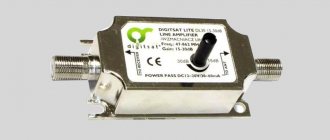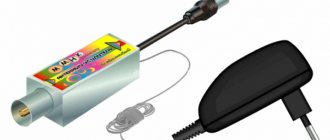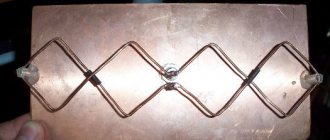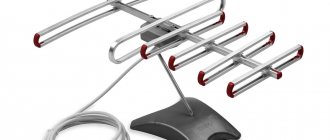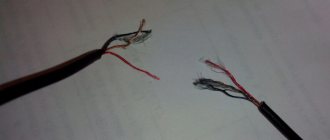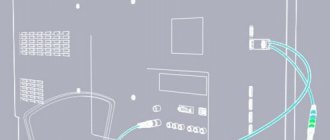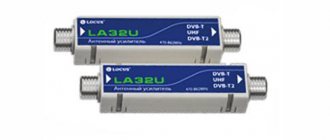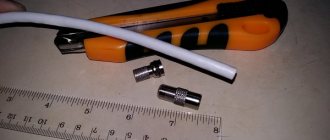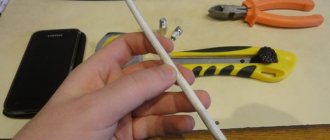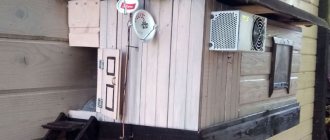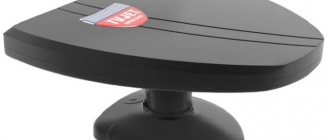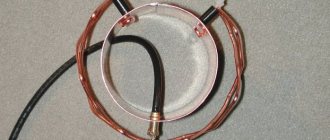Last updated May 2, 2021
A television antenna amplifier is a specialized device designed to increase the power of an electromagnetic wave pulse. In other words, the main task of the device is to amplify a television or radio signal.
The advantages of antenna amplifiers include signal filtering, which leads to reduced interference and improved quality of certain ranges.
Below is a rating of the best TV antenna amplifiers that you can buy in 2021.
What are antennas like?
Depending on the type of receiving radio signal, the antenna can be digital or analog.
- Digital is designed to receive DVB-T2 signals, which transmit data in decimeter waves.
- Analogue is needed to display channels of the same name. Waves of meter length are transmitted, which means that the dimensions during manufacturing are kept appropriate.
Therefore, in order for a TV antenna to work well, you need to know the dimensions for manufacturing.
There are also broadband antennas. The conductors of the design are made of different lengths, which makes it possible to catch both the MV and UHF ranges at once. So, if you need to set up digital and analog TV channels at the same time, then you need to install an all-wave device.
Depending on the location of installation, they are divided into indoor (home, room) and outdoor (outdoor). Homemade digital indoor antennas, and even factory ones, can pick up channels only if the repeater is close. Moreover, the signal must reach the window where the structure receiving the signal is installed.
Outdoor ones are characterized by greater power, therefore they are better for use than indoor ones.
They are divided into individual and collective.
- Individual digital antennas are purchased separately by each resident of the house and installed outside independently or with the help of a specialist installer.
- Collective (or common house) ones are installed on the roof of apartment buildings. Provide signals to all residents at once. You cannot connect yourself and fix possible problems in the future. Maintenance is carried out by specialists from the company that installed the antenna.
The type of action can be:
- passive - they do not amplify the received signal, and the reception itself is ensured due to the design of the on-air receiver;
- active – in addition to reception, the signal is amplified. The receiver has an amplifier board, which is powered by an external power supply or digital set-top box via a coaxial cable.
By the way, if you bought a passive antenna, and the signal level on the TV or set-top box is not the highest, then you can make the design active. To do this, an external amplifier is connected to the cable television line indoors.
What you need to know about amplifiers
Despite the obvious advantages of amplification devices, there are significant disadvantages.
Advantages:
- no need to purchase a new antenna (connecting the structure to an amplifier will lead to a significant increase in the signal);
- the length of the TV line can be neglected. In many cases, the power of the television signal increases so much that even a long television path will not interfere with the normal reception of channels.
List of disadvantages:
- Only a knowledgeable person can make an antenna amplifier with his own hands. Therefore, the device is almost always purchased separately. The cost is not so high that it will hit your pocket hard, but you will still have to spend some money. If the amplifier is not initially built into the structure, you will need to install it yourself. To do this, you will need to buy several more connectors for connecting to the amplifier, you need tools and at least the initial ability and desire to cope with the task.
- The operation of an amplifier is based not simply on amplification, but on copying the signal. Only an already amplified version of the original signal is created. The electronic signal can only be increased with external power. Therefore, the amplifier needs to connect a power supply. The easiest way is when DTV works through a T2 receiver. In the set-top box menu, you can enable the “Antenna power” option. Then there is no need for external power. The set-top box itself will power the amplifier via a coaxial feeder. If the terrestrial DTV setup is done directly on the TV, then you will have to use third-party power from outside. For this purpose, a power supply is purchased. Another power supply is a combination amplifier. The device already has a block inside the device body. Then you only need to connect with a cable from the DVB-T2 antenna.
- In a television coma, another signal may be received. In this case, interference and noise are meant. If the signal is not “clean”, the amplifier will also increase the noise level.
- Excessive amplification has a negative impact on the “digital”. If the TV signal level is high, using an amplification device may have a bad effect. The digital decoder on your TV or tuner will not process excessive TV signals. Therefore, it is always recommended to look towards using an amplifier with a regulator. An adjustable “valve” will allow you to get rid of “excessive” gain.
From the above, the conclusion suggests itself: the amplifier is justified only for a weak, but at the same time clean radio signal.
What to consider when choosing
If you watch only digital television, then you can safely take a universal amplifier for the DWM range. When using digital and analog television simultaneously, it is better to take a universal amplifier. This way you can enhance the reception of both types of TV broadcasts at the same time.
The best choice is always an antenna with a built-in amplifier. The device is a board (SWA), which is hidden in a plastic casing directly on the receiver.
But if you didn’t plan to change the antenna, you can’t do without an external device. Then there is only one parameter left to choose - the power type. There are two types: with direct power supply (Fig. below) and external. In most cases, the type with power supply via cable (external) is selected. Another option is also possible, it has much larger dimensions, and therefore more power. Power comes directly from the outlet through the network cable extending from the device.
Connection diagrams
Depends on the antenna (active or passive) and the equipment involved.
If the amplifier has built-in power
The scheme is distinguished by its simplicity. The user only needs to cut the TV cable into two parts in the area closest to the antenna in the room. Next, F-connectors are put on both ends of the cable. Then the connector on the TV cable leading from the receiving device is screwed onto the thread of the amplifier's input jack (INPUT). The other connector connects to the output port. Then the power cord is plugged into the outlet.
If you need to watch more than one TV, then a splitter with the required number of ports is connected between the TV receiver and the amplifier. The maximum permissible number of channels on one divider is limited to 8 pieces. But if necessary, you can connect several dividers in series. This way it will be possible to increase the number of connected equipment in one television system.
If the amplifier is without its own power supply
The connection diagram is no different from the previous one. The only difference is the need to connect the adapter powering the amplifier to the TV cable.
The connection is made through a separator - a signal-voltage separator. Since power and signal will be supplied through the same cable, mixing must be avoided. This task is performed by the separator.
Externally, the separator is a small box with an antenna plug. You need to disassemble the separator, strip the cable and secure it with bolts in the clamp on the board.
Next, the separator plug is inserted into the antenna input of the TV or set-top box.
If a splitter is used, the separator is connected through an adapter that is screwed onto the input of the divider.
You can also put a separator on any final section of the television circuit, i.e. at the input of the first, second or nth TV. Then the power must pass to the amplifier through a divider. Therefore, a voltage-passing device is required. You need a splitter with power supply.
This is true for any circuit where power is provided externally.
If an active antenna is connected
The system setup algorithm is no different from the previous scheme. Just don't cut into the amplifying device inside the line.
How a digital antenna for a TV works: I’ll explain it simply
Before you start assembling any of the four models of receiving antennas, you should have a good understanding of the processes that should take place in them.
Electromagnetic waves propagate in all directions of the horizon from the electrical signal transmitter generator installed on the television tower.
They have sufficient power for their coverage area, but their signal weakens as distance increases. Its magnitude is also affected by the terrain, various electrical and magnetic obstacles, and the state of the atmosphere.
In a vibrator oriented perpendicular to the movement of the electromagnetic wave, voltage is induced according to the laws of induction. The positive and negative half-waves of the harmonic create their own sign.
The voltage reaches its maximum value - amplitude at points of time corresponding to ¼ and ¾ of the period or 90 and 270 degrees from the sinusoid of electromagnetic wave intensity.
Any shape and size of active vibrators are created for the most effective voltage induction with minimal energy loss. The position of these points is calculated using the wavelength or harmonic frequency.
The voltage, closed to the internal resistance of the television receiver, generates an electric current in the created circuit. Its shape and direction change and proportionally repeat the signals of the transmitter on the active load.
Due to the use of various types of digital modulation on the transmitter side, information signals are received and processed within the television receiver circuit.
I will not go further into considering the question of how a digital antenna for a TV works during its creation.
What technical characteristics of the antenna determine the quality of TV signal reception?
The antenna is classified as a reversible device because it works the same on the transmitter and receiver sides. When analyzing the characteristics, its inclusion is used as a generator.
To effectively receive a digital signal, it is necessary to take into account that on the generator side, the emitter of electromagnetic waves can be positioned at any angle to the horizon, but only two directions are legally accepted: horizontal and vertical.
Our task is to repeat this orientation for our own TV.
The direction of polarization and other digital signal transmission data can be found on the operator’s website through a search engine.
We go to the website and select the required information.
We are primarily interested in 3 characteristics:
- channel number and its frequency, for which we will create an antenna according to strict dimensions;
- the radius of the transmitter service area, which affects the signal quality and the choice of vibrator design;
- direction of polarization.
The distance the TV is located from the transmitting tower greatly affects the design of the antenna.
The higher the antenna is installed, the better the quality of the received signal, but the length of the cable can weaken it significantly. In this regard, residents of the upper floors of multi-story buildings have a significant advantage over their neighbors below.
For a reliable reception zone, I tested the simplest Kharchenko models and loop assemblies made of coaxial cable and wire, which have a wide range of reception frequencies.
For long distances it is better to assemble a wave channel or a log-periodic circuit. Of the simple designs, the Turkin antenna, modified by Polyakov, has proven itself well.
For example, in my area the distance from the TV tower was 25 km, which is within the zone of reliable reception, and the signal frequency is 626 MHz of vertical polarization.
I calculate the length of the electromagnetic wave through the speed of light by frequency: λ=300/626=0.48 meters. The half wave will be 24 cm, and the quarter wave will be 12.
Based on these characteristics, I made 4 test antennas for digital television with my own hands, which I describe below.
Comparison table of the presented models
To visually compare the models presented above, we use a comparison table.
| Model | Frequency (MHz) | Gain (dB) | Dimensions (mm) | Weight, kg) | Price, rub) |
| Terra HS004 | 47-862 | 34-44 | 135x180x52 | 0.7 | from 3,200 to 3,780 |
| Alcad AL-200 | 47-862 | 14-24 | 101x57x28 | 0.4 | from 1,350 to 1,600 |
| Rexant 05-6202 | 5-2500 | 25 | 60x40x20 | 0.1 | from 190 to 380 |
| Lans LX-50 | 47-862 | 16-20 | 88x76x20 | 0.2 | from 980 to 1,100 |
| One For All SV9345 | 87-862 | 43 | 43x43x213 | 0.7 | from 2,399 to 2,899 |
| REMO BAS-1321 | 87-862 | 43 | 1050x290x90 | 2.3 | from 1,760 to 2,030 |
| Harper ADVB-2440 | 87-862 | 30 | 115x115x235 | 0.5 | from 1,399 to 1,670 |
How to make an antenna for a TV
Below are step-by-step instructions to make a DVB-T2 antenna with your own hands. Attached are links to additional detailed instructions where you can learn more and see a more accurate creation algorithm.
From cable
The advantage is ease of manufacture. You don't need to be an experienced electrical engineer. You only need to mark the cable according to the exact dimensions and strip it with a knife. It is also used indoors, but can also be installed outside if the structure is well secured and exposed areas are protected from moisture (rain).
Disadvantage: There is no point in connecting an amplifier. There will be no effect from the device. It only catches a nearby strong signal, which arrives without interference to the antenna.
To make a digital receiver, you need to have:
- a cable of the required length (you can use an old cable from a previous television line if you plan to lay a new one);
- ruler;
- knife;
- plug for connecting to a TV connector.
Reasons for signal deterioration
Each reason for the deterioration of the air must be analyzed individually, since its reception depends on local conditions: on the direction in which the signal passes, what obstacles are in its path, on the presence of hills and tall buildings in your area.
Before you finally decide to use an amplifier for your TV, let's take a look at the most likely causes of TV signal deterioration.
- Transmitter Maintenance
In almost all cases of problems with TV display, the cause is on the user's side - cases on the sender's side are usually a break in servicing the transmitter, which sometimes takes several hours.
- Equipment malfunction
External antennas are exposed to external natural influences every day. Frost, heat, snowstorms and rain - the antenna can withstand all this for years. If it is installed correctly. And if not, then one day moisture will penetrate into the wires, splitters, amplifiers, and the problem will arise at the least expected moment.
- Wrong antenna
The most common reason for poor reception is that the signal level coming from the antenna is too low. The only correct solution would be to use its best model - preferably directional, not necessarily with an amplifier. But the situation can be partially improved by installing the antenna higher.
- Signal strength too high
Excessive intake levels can also be a common cause of problems. Living near a TV tower and using a high gain antenna can overload the signal at the tuner input.
- Cables
Coaxial cable has a significant impact on reception quality. An old cable with frayed insulation, bought at a flea market, or worse - a cable from pieces that you scraped up from barns and barns, can cause such severe attenuation that it will absorb the signal from even a very good antenna before it even reaches the TV .
- Separators and connectors
You may be interested in: Connect a monitor to a digital TV set-top box
The properties and number of splitters used also affect the picture quality. Each such passive element (i.e. one that is not an amplifier) reduces the reception level. Careless installation of connectors, especially outside the home, can lead to rapid oxidation of the connections and, as a result, to significant attenuation of the TV signal.
- Noises
We are surrounded by a lot of transmitting devices - relay stations, mobile phones, modems, routers, radio stations, alarms, etc. Radio waves from different frequency ranges can interfere with TV reception. Even devices without antennas cause interference: microwave ovens, fluorescent lamps, electric cars.
Location and connection
Speaking about homemade devices, they do not need to be connected to the roof. It is enough to simply attach the “homemade product” to the window (on the wall of the house), pointing it towards the tower.
The TV antenna is connected via a TV cable, attached on one side to the TV, on the other - to the structure itself. Next you need to go to the settings section by clicking on the “auto settings” button.
TV antenna amplifier - what is it?
If you look at it, a TV antenna amplifier is not a very complicated device. This is a simple microcircuit designed for a power supply of six to twelve volts. Sometimes it doesn't even need an internet connection. Question: what causes the signal to be amplified? We will understand this without using complex terms and definitions.
The signal enters the transformer from the antenna and is then sent to the transistor. In a transistor, the TV signal is amplified, and only slightly. Then its path lies through the emitter. Then, using cascade transistors, the frequency is adjusted. This is a simple description of a complex thing at first glance. After this, the signal is sent to the TV.
What affects the quality of reception?
Let's consider the main factors that affect the quality of signal reception.
The quality of the signal is directly affected by two things: the reception range and the quality of the amplifier itself. In the first point, everything is clear - the greater the distance from the distribution point to the signal reception point, the worse it will be. Basically, the values of this indicator reach 10-20 km, after which the signal becomes much weaker.
The quality of an amplifier directly depends on its characteristics: frequency range, gain and efficiency, and other factors that will be discussed below.
Is it possible to receive a digital signal without an amplifier?
The question often arises and interests many people.
Important! With the proper approach, it is possible to receive a TV signal with normal quality, not only without an amplifying device. At a distance of up to fifteen kilometers from the repeater, it is possible to view the TV receiver even if you do not use an antenna. The antenna can be replaced with a short piece of wire. Coaxial cable is best for this.
Why is the digital television signal bad?
Initially, you should familiarize yourself with the reasons due to which the signal quality may be impaired. Probably, having corrected several provoking factors, you will not have to install an amplifier:
- The repeater is located far away.
- Incorrectly selected antenna for the TV.
- Presence of natural noise.
- Obstacles such as trees or large structures.
- Damaged cable.
- Transmitter orientation is incorrect.
- Old equipment.
- Bad weather.
- External interference at the antenna. This includes metal. For example, there are metal objects near the antenna through which electricity can pass.
- The television signal is distributed to several receivers at once.
Features and circuit of the antenna amplifier
An amplifier is a device designed to amplify a poor, unstable TV antenna signal. The advantages of this device are as follows:
- amplification of a television signal in a fairly wide frequency band;
- the ability to receive even a very weak TV signal;
- quiet operation
The disadvantages include:
- the risk that the device will self-excite;
- High power signals in the meter wave range may overload the device;
- susceptibility to the effects of lightning currents;
- passive output losses.
The DIY antenna amplifier diagrams indicate how the device should be connected to the TV. The TV cable goes to a device that amplifies the signal, and then the signal goes to the TV. This scheme is universal.
Selecting an amplifier for your TV
Not every antenna amplifier works perfectly, some of them have considerable noise of their own, others are even worse and are easily excited. Therefore, if you get a bad result with one antenna amplifier, you can try choosing a TV amplifier of a different model or with a different power supply. For example, experiment to see if the antenna will work better if the voltage is supplied not from the “native” power supply, but from a digital tuner.
An antenna amplifier will not help or even harm if:
- the reception level goes off scale beyond the amplifier's maximum parameters;
- the antenna, in addition to the main signal, catches strong interference, which the amplifier will increase;
- The signal level is extremely weak.
Analog signal amplification
The golden rule of good TV reception: in order to receive a good analog TV signal, it is advisable not to degrade it. To prevent this from happening, lay the cable correctly, monitor the serviceability of the antenna and promptly diagnose any depressurization in your apartment television network.
If the distance to the transmitting transmitter is large and the reception is very weak, then you will additionally need to install a signal amplifier.
If you are receiving analog broadcast on a passive antenna and distributing the signal to several receivers, then first it needs to be amplified, and only then divided into directions. An active antenna splitter can do this.
Cable TV amplification
Cable networks haven't changed much since their inception. The local cable TV provider receives quite a lot of television channels from the satellite, forms a television package from them, and distributes them to our homes via coaxial cables, charging each subscriber for this. To reach our house, the signal passes through an intermediate main TV signal amplifier several times, enters the TV signal amplifier of an apartment building, is amplified again in it, and is distributed throughout the apartments. And yet, while this signal was coming from the premises of the provider company into our house, it weakened a little.
That's right, cable TV is quite noisy. How to improve its quality? We must admit: if you are a cable TV subscriber, then you have little chance of fixing anything. Poor cable reception is the problem of the provider, and there is very little chance that they will do anything to eliminate the problem. All you can do on your part is to replace the passive cable splitter with a TV signal splitter with an amplifier, and possibly the entire cable with connectors with new and better ones.
Conclusion: you need to distribute not analog TV, but digital TV, using fairly modern signal transmission systems via fiber optic cable. The quality is excellent and there are many more TV channels that can be transmitted.
Satellite Signal Boost
The problem of amplifying satellite TV is such that in receiving a signal from a satellite, the diameter of the satellite dish, being the determining parameter, and the accuracy of the antenna tuning still play a key role. Speaking about enhancing reception from a satellite, you should understand that we are not talking about the incoming signal that the satellite emits (you will not amplify it in any way), but about saving the received signal and, having amplified, “pushing” it along the cable to the satellite set-top box , minimizing attenuation. A satellite TV antenna signal booster is more of a preventative measure than a panacea for poor reception.
The principle of operation of a TV antenna
Intermittent broadcasting distorts the picture and sound, but the problem is not always on the side of the television tower. The problem most often lies in the receiving device. You can try to amplify a weak signal to avoid noise and interference during viewing. Let's consider both types:
- Satellite dish - the gain depends on how wide the dish is in diameter. There are several varieties, all of them outdoor.
- Television can be indoor or outdoor (these are installed on the roofs of houses).
The quality of the signal in the second case depends on the proximity of the broadcast tower, the design and the presence of an amplifier. In other words, the antenna receives it, converts it through the receiver, and the image appears on the TV screen.
IMPORTANT! The quality of the signal does not depend on the type of television cable (if it is damaged, there will be no sound or picture at all). Therefore, if you have problems with broadcast reception, you should check the antenna.
Correct installation of the amplifier
To obtain maximum effect, the amplifier must be installed immediately at the entrance to the apartment, before wiring begins. This will help maintain sufficient signal-to-noise ratio at maximum gain. The most effective wiring will be if you combine all the cables into one divider installed immediately after the amplifier. If this is not possible when wiring in series, use taps rather than dividers.
Use a ground isolator to protect the amplifier. Do not use old or thin cable (less than 7mm). Over time, the cable loses its properties, and losses increase significantly. A thin cable has a small cross-section of the central core, which increases signal loss. Do not block the amplifier's ventilation openings with foreign objects, e.g. newspapers, curtains. When installing, mount the amplifier in a position that will allow minimal bending of the television cable. There must be at least 10 cm of free space for ventilation at the top, front and bottom of the installed amplifier.
How to choose a signal amplifier for your TV
The modern market presents many different models, for this reason, many people find it difficult to decide which device suits them best. To make the right choice, you should consider several important parameters:
- Gain. It should be calculated based on the approximate distance between the TV and the signal source (tower). It should not exceed 150 km. At a distance of no more than 10 km, there is no need to amplify the signal; you just need to choose a suitable antenna. If the distance between your home and the source is more than 10 km, you should not purchase a device with a coefficient higher than necessary - this will lead to the opposite effect and instead of a high-quality image you will see new interference.
- Antenna type. For example, swa models are suitable for array receivers, which operate in the frequency range from 49 to 790 MHz. Some of the most popular modern Locus models are perfectly compatible with LSA amplifiers.
- Frequency range. A good solution for a conventional outdoor receiver (which receives waves of any frequency) would be to install a broadband model, but a better result is shown by a device that operates only in a certain range.
- Noise figure. The lower this parameter, the better the image on the TV screen will be.
Criteria for correct selection
The procedure for selecting an amplification device is not particularly complicated. This equipment is designed to improve the quality of on-air reception, so its choice will be determined, first of all, by the quality of the incoming signal, which will direct you to connect a device with a suitable gain.
But do not forget that if the signal in your area is weak, it is important to take into account the antenna’s own gain, as well as the height of its placement. An amplifier will be useful when the distance from the antenna to the decoder is significant, and it is necessary to amplify the signal in order to reduce its losses in the cable.
When choosing a signal amplifier for an antenna, it is also important to be guided not only by its amplification capabilities. The parameters of the device’s own noise are equally involved here. Both the signal strength and its quality at the very beginning of your home TV network will have a decisive influence on the correct functioning of the entire installation, ensuring clear and flawless broadcasting on your TV.
A good amplifier for a TV antenna can be powered by the voltage generated by the tuner itself - this gives a good chance for the final video quality. Therefore, it is better to purchase devices in which the microcircuit is powered by 5 Volts.
How to strengthen a TV antenna yourself
There are three simple ways to boost your signal yourself. They do not require large expenses or specialized knowledge:
- Use an amplifier - you can purchase it in a store and install it yourself.
- Use connected devices - they will give the best signal. It is best to place them as high as possible.
- Expand reception coverage - as with a plate, diameter matters. You can supplement a conventional antenna with thin wire, making a housing around it with segments similar to the type of rays.
The antenna can simply be moved by finding the optimal place to receive the signal. Such amplification methods are universal and, quite likely, they will be enough to improve the picture on the TV screen.
What factors influence the deterioration of a TV signal?
The symptoms of poor analog TV reception are not difficult to notice - the picture is distorted and disappears. As for the attenuation of digital television, it is also easy to detect, but the only difference is that we are not dealing with ripples (snow) on the screen, but with breaks in the video stream. With a weak TV broadcast, the image may freeze, crumble into pixels, or change color (usually green).
Signal amplification methods
TV antenna signal amplification is achieved in 5 ways:
- Use a higher quality TV antenna than the one you have. Depending on the design, a few decibels of gain can be gained here. Check if your antenna is selected correctly.
- Precise orientation. Almost all devices operating in the UHF range have a clearly oriented diagram and most efficiently receive a signal from one direction. Even a rotation of 5–10 degrees can give a serious increase in signal strength.
- Replace cable. If the distance between the antenna and the television receiver is too large, the lion's share of the received signal power is lost due to the resistance of the conductor. This can be avoided by using a feeder with reduced resistance (for example, with a central core made of pure copper rather than copper-plated steel).
- Move the TV closer to the antenna. The cable becomes shorter: in some cases, even 2–3 meters can be decisive. Reducing the feeder length allows you to avoid unnecessary signal power losses.
- Use an antenna amplifier.
Types of television amplifiers
Devices are divided into categories most often based on two parameters: installation location and frequency range. This applies both to antenna amplifiers specifically and to related analogues - television and satellite.
According to the frequency range, there are three types:
- range;
- multi-band;
- broadband.
A range device amplifies the signal only in a certain, specified frequency range - meter or decimeter. One of its functions is to reduce noise that appears as the cable length increases.
Multi-band devices operate equally efficiently in different frequency ranges and can also receive signals from multiple sources.
The broadband amplifier operates in the meter and decimeter ranges and is used for digital television.
A sample broadband device is model GAL AMP-101. The connection is made through a coaxial cable and a separator. Gain – 20 dB
According to the installation location, all devices are divided into external (mast) and internal. External ones are mounted in the place where the television antenna is installed - on a pole or mast fixed to the balcony or roof. They feature durable protection.
Internal amplifiers are located close to the receiver. Their disadvantage is the losses associated with the cable length.
Making a digital signal amplifier: materials, tools, circuits
Any novice radio amateur who has just learned to hold a soldering iron can make an antenna amplifier for receiving digital television. The main thing is to choose the scheme you like from the many that can be found on the Internet. You will need a minimum of tools - a soldering iron, a cutter and pliers. Well, all the necessary material, such as circuit elements, wires and other consumables, can be purchased at any radio electronics store or even ordered online.
Connecting and setting up an antenna amplifier to a TV: how to do it
If the circuit is assembled correctly and the elements are correctly selected, there is no question of any adjustment. A cable TV signal amplifier between a splitter (diplexer, splitter, tee - whichever is more convenient) and a TV. If you need to supply power to it, you should consider having a source nearby. Moreover, if power is supplied to the device, then, if desired, such an active antenna can easily be turned into a passive one by simply unplugging the unit from the outlet.
Methods for ensuring reliable TV signal reception
There is no ready-made recipe. Each case is specific and requires an individual approach. What to do in this situation? In many cases, the signal does not require maximum amplification, just as it is not necessary to amplify the entire “bouquet” of signals.
You may be interested in: How to connect an antenna to a TV
To make sure which case we are really dealing with, it is necessary to accurately measure the signal level from the receiver antenna. This is necessary in order to understand whether we are receiving a direct or reflected signal (or even several), and determine further steps.
One way to get reliable reception is to correct the direction of the antenna or its location in height, and often both. Sometimes it is enough to move the antenna mast a meter or two to get much better quality broadcast.
It is also worth having a level meter on hand when you need to make sure whether the broadcast quality is sufficient and only requires additional amplification, or perhaps you are receiving a strong but excessive signal? In case of a strong signal, you can choose the right antenna. It may also be enough to deliberately change the direction of reception or the location of the antenna to weaken the signal while at the same time eliminating its reflected rays.
When receiving digital TV, you should remember that when strong radio frequency oscillations are superimposed on each other, you need to opt for a passive directional antenna without the use of any amplifying elements. The amplifier to the TV antenna in this case will contribute to intermodulation, which will lead to failures and instability of the digital decoder.
Methods for amplifying TV antenna power
In fact, ways to increase the power of a TV antenna can be correlated with medical approaches: use “therapy” or immediately go the “surgical” route. As for drastic measures, the very first step here is to change the antenna itself to a stronger and more expensive one. This also includes purchasing an active antenna instead of a passive one.
But you can act more gently, especially if your antenna has served you honorably for more than one year:
- experiment with the direction of reception;
- raise the antenna higher;
- if possible, clear the path for the signal;
- eliminate all “non-contacts”, replace the cable;
- equip the antenna with a signal amplifier. Many external antennas have the technological ability to install an amplification board if it turns out that one is needed.
Using an antenna amplifier
TV antenna signal amplifiers are the very first, after the antenna, to perform the initial correction of its level.
The type of device that's right for you depends on the reception conditions in your area and the specific needs of your entire TV installation. If you need to amplify the entire RF band, you can use a fixed gain broadband amplifier. If, on the contrary, in your region the correct reception of frequencies from the upper UHF band is significantly influenced by high-frequency transmitters and interference occurs, caused, for example, by passing cars or a neighbor's lawn mower, then you will need a different amplifier model - with a fixed gain, but with a limited operating range frequency
Modern amplifiers from various manufacturers have a fairly ergonomic shape, which, in fact, allows them to be mounted anywhere on the coaxial antenna cable. This means that you can use the amplifier in an existing antenna installation without having to disassemble the antenna. However, it should be remembered that due to the violation of the signal-to-noise ratio with increasing distance from the antenna, it is recommended to install it as close to the antenna as possible.
Do-it-yourself amplifying device: advantages and disadvantages
Important! It is much easier to buy digital television signal amplifiers online from Chinese manufacturers. Such a device is cheap, and its delivery will be free.
Only such things can encourage you to start making an amplifier yourself - this is the desire to make something of better quality, as well as improve your amateur radio skills. You won't be able to achieve big savings with this option.
Important! If a radio amateur plans to receive a digital signal, then in this case the receiver must be equipped with a “DVB-T2” digital tuner. Otherwise, you will have to purchase an additional receiver for your TV, with which you will be able to watch TV channels in the desired frequency range.
The best manufacturers of TV signal amplifiers
- Terra
The company has been known since 1980, when it began supplies to the Russian and Lithuanian markets. It is a manufacturer of high-quality equipment for satellite, cable and terrestrial television. Currently, the company exports products to Europe, Asia, Africa and Australia.
- Eurosky
Chinese manufacturer of broadcast equipment. Satellite receivers of this brand are popular all over the world. Their main feature is great functionality and at the same time low price.
- WISI
German company. Its history began in 1926, when Wilhelm Zin opened his own business in the city of Niefern for the production of semiconductor receivers, plugs and radio components. Since 1935, the company began producing television antennas, and since the 80s of the last century, equipment for CATV. Since 2003, WISI has been the leader on the German market.
- Alcad
A brand with a thirty-year history of success. This is an international company whose headquarters are located in Spain. Alcad has branches in Turkey, the UAE, the Czech Republic, and France. Offices with sales representatives are located in 60 countries. The products are marked with the CE mark.
- REMO
Domestic manufacturer. Saratov Electromechanical Plant was established in 1991. The company's products have repeatedly received the title of diploma winners and laureates in the field of “100 Best Products of Russia”. Today REMO is known not only in Russia, but also abroad. How much does the product cost? Quite affordable for the average buyer.
- RTM
Russian manufacturer. The company was founded in 2001. Its main products are telecommunications equipment for cable television. The company keeps up with the times, new products from RTM are constantly appearing on sale. In particular, this year the model range of connectors and adapters for coaxial cables is being updated.
- Antex
The Ural manufacturer dates back to 2006. Specializes in antenna equipment. Today the company produces antennas of the following standards: GSM900, LTE2600, CDMA450, WIFI, VHF, UHF and many others, as well as equipment for them. The production site is located in Irbit, the main office is in Yekaterinburg.
Before deciding which device is best to buy, you should take a closer look at the products of these companies.
TV signal amplifier: make it yourself or buy it
Many people ask this question. If we think from the point of view of justification, then it is easier to purchase a digital signal amplifier for a TV on any Chinese resource. The device is inexpensive and delivery is free. However, if you want to do everything yourself, you can purchase all the parts there, taking one of the schemes for execution. It won’t cost much less, but many people are simply interested in the radio business.
By the way, it is worth noting that if a home master wants his TV to receive a digital signal, then his TV must be equipped with a special DVB-T2 module. Otherwise, you will need to purchase a receiver for your TV that will allow you to view channels in the appropriate frequency range.
Making an antenna that doesn't need amplifiers
We must warn you right away - if the distance to the TV tower is more than 15 kilometers or there are a large number of obstacles in the path of the signal, then you cannot do without an amplifying device. If there are no problems described above, then the antenna can be made in about 10 minutes.
Step-by-step algorithm:
- The first thing you need to do is find out what channel the signal is broadcast on in the region. Open the link www.rtsr.ru and go to the RTRS web page. Then we indicate our current location.
- Scroll down and find the phone number by which the user can find out the broadcast channel.
- We enter the channel data in the appropriate field that will appear when the TV is switched to manual tuning mode. The frequency that will be needed to calculate the cable length will be displayed below.
- Then we take a calculator. To calculate, we use the following formula: 7500 divided by the frequency in MHz. We always round the result up.
- For example. Frequency in the Samara region is 754 MHz. Divide 7500 by 754 and get 9.9. This means that the cable length must be 10 centimeters.
- Initially, there is no need to shorten the cable. We install a simple television connector on it, which is connected through a coupling to the cable.
- Next we take measurements. We retreat 20 mm from the plug. There will be a bend at this point. This is where you should measure the required length. In our case it will be 12 cm (2+10=12). Next, the cable is cut at the outermost mark.
- Then remove the insulating layer from the 20 mm mark. to end. This is very easy - modern cables have a very soft outer layer.
- Afterwards we remove the shielding layer. We don't need him at all.
- At the 20 mm mark. The cable is bent at an angle of thirty degrees. After this, the antenna is ready for use.
- We position the antenna so that it is directed towards the TV tower. There is no need to hang it outside the room. In the room the signal, although lower, will be quite sufficient for normal reception.
To summarize all of the above. Without an amplifying device, you can make a TV antenna yourself. In this case, such an antenna will function at the level of the factory analogue.
Rating of the best amplifiers for antennas
| Nomination | place | Name of product | price |
| Rating of the best amplifiers for antennas | 1 | Terra HS004 | 3 540 ₽ |
| 2 | Alcad AI-400 | 2 350 ₽ | |
| 3 | WISI VM 8351 | 2 800 ₽ | |
| 4 | Lans LX-50 | 1 400 ₽ | |
| 5 | Remo BAS-8102-01 | 499 ₽ | |
| 6 | Antex AX-C20U | 450 ₽ | |
| 7 | Remo USSH-5V | 113 ₽ |
Terra HS004
Rating: 4.9
A very expensive amplifier. Its high cost is due to the fact that it is designed to amplify a wide variety of frequencies. The reliable cast housing also played a role in increasing the price tag. It is almost impossible to disable the Terra HS004 - it even has protection against voltage surges.
This amplifier is mainly used by owners of walkie-talkies. This is evidenced by the ability to work with the VHF and UHF bands. I'm glad that this model can split these ranges, allowing you to separately adjust the gain of each of them. To be precise, the device has access to frequencies from 47 to 862 MHz. The gain is adjustable from 34 to 44 dB. At the same time, a specialist will not be surprised that the VHF range is subject to greater amplification than UHF.
Power for this model is provided by an ordinary plug that is inserted into a socket. Therefore, the miniature power supply is located inside the device itself - this is good news. As for noise, its level does not even reach six decibels.
The amplifier is capable of operating at a variety of temperatures - even at 20 degrees below zero. However, there is no moisture protection as such. On the contrary, the case has a large number of ventilation holes, thanks to which the device hardly heats up. It turns out that placing the amplifier outside the room is not recommended.
A nice bonus is the presence of lugs here, thanks to which the Terra HS004 can be mounted somewhere on the wall with ordinary screws or bolts. In short, this is an excellent copy for some special services and other organizations that regularly face the need to improve the quality of signal reception in the VHF and UHF bands. However, digital television broadcasts in the same ranges, so the amplifier works with it too. But does it make sense to buy such an expensive device to amplify an indoor antenna?
We draw your attention to the existence of a model under the index Terra HS004L. It differs from its analogue only in the presence of an LTE signal suppression filter.
Advantages
- Can be mounted on a wall or any other surface;
- Division into subranges;
- There is a version with an LTE signal suppression filter;
- Possible power supply via RF input;
- There is protection;
- There is a DC overload indicator;
- There is a test connector at the output;
- Excellent die-cast housing;
- High gain;
- A large number of connection points can be implemented.
Flaws
- Very high cost.
DIY photo antenna for digital TV
Sources
- https://gidpotv.ru/antenna-dl-tsifrovogo-tv-svoimi-rukami.html
- https://ElectrikBlog.ru/antenny-dlya-cifrovogo-tv-dvb-t2/
- https://PoTelevizoram.ru/efirnoe/antenna/dlya-tsifrovogo-tv-svoimi-rukami
- https://seeiptv.ru/6-sposobov-sdelat-komnatnuyu-antennu-dlya-televizora-svoimi-rukami/
- https://VashUmnyiDom.ru/svyaz/usilitel-dlya-antenny.html
- https://tytmaster.ru/antennyj-usilitel-svoimi-rukami/
- https://gorkogo29.ru/vyshivka-i-shite/kak-usilit-antennu-dlya-televizora-svoimi-rukami.html
- https://encom74.ru/izgotovlenie-usilitela-signala-televizionnyh-antenn-ulucsenie-priema-svoimi-rukami/
- https://homius.ru/usilitel-tv-signala-svoimi-rukami.html
- https://svoimirykami.guru/antenna-dlya-cifrovogo-tv-svoimi-rukami/
